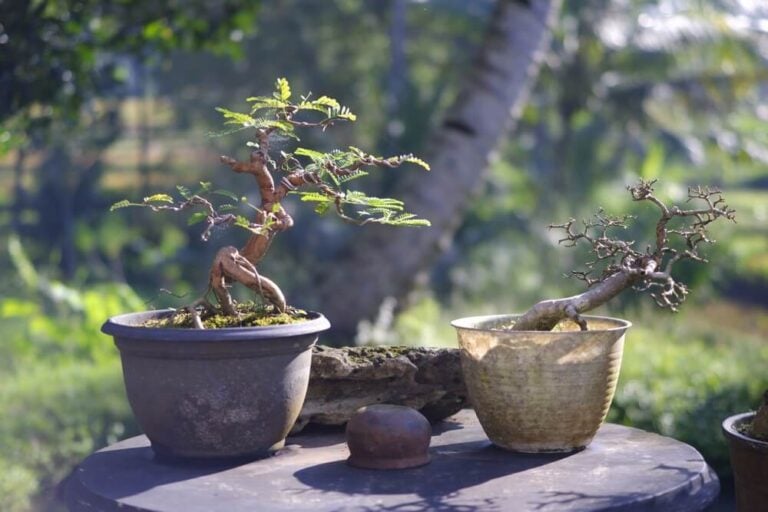21 Best Butterfly Varieties For Home Gardens And Backyard Pollination!
Welcome! This article contains affiliate links, meaning I get a commission if you decide to make a purchase through my links, at no extra cost to you.
Here are the best butterfly varieties every gardener should welcome into their landscape! When these butterflies appear, it’s a sign you’re doing something right. These elegant pollinators are nature’s stamp of approval, often indicating healthy soil, diverse plant life, and a thriving ecosystem. They also add a magical beauty that transforms any outdoor space into something truly special.
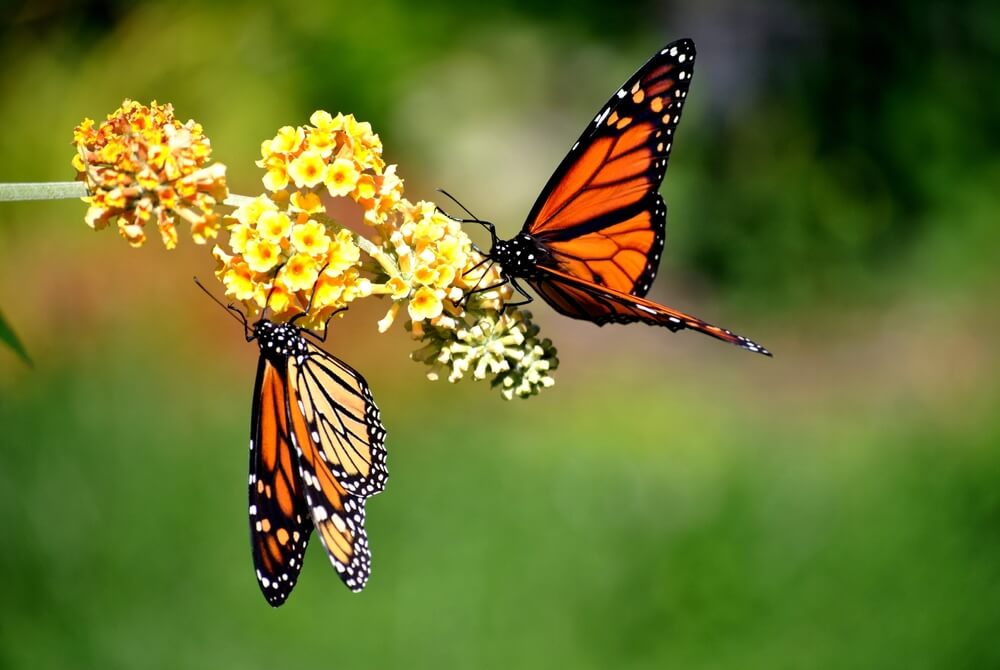
Sound intriguing?
Then, let’s examine the most beautiful butterflies!
21 Best Butterfly Varieties For Backyard Gardens And Pollination
Here are our top 21 most spectacular butterfly species that deserve a place in every pollinator-friendly garden.
1. Question Mark (Polygonia interrogationis)
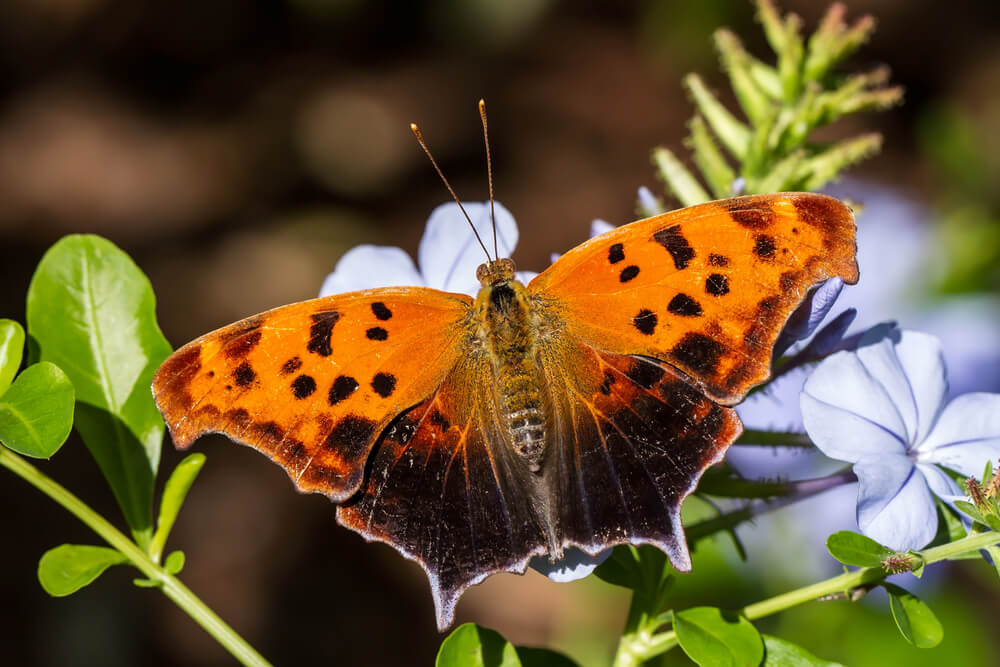
This curious butterfly gets its name from the silvery question mark on its underwings. It’s like nature’s own punctuation mark! With ragged, orange-brown wings that look like autumn leaves, it’s a master of disguise. The Question Mark lays its eggs on plants like nettles, elms, and hackberries. Surprisingly hardy, adults can even overwinter in sheltered places, emerging again in spring.
- Markings: Orange wings with black spots. Question mark shape on the hindwing.
- Host Plants: Elm, hackberry, nettle.
- Nectar Plants: Sap, rotting fruit, aster.
- Range: Eastern and Central US.
This butterfly’s summer form is brighter orange, while the winter form is darker and more camouflaged, like nature’s seasonal wardrobe change.
2. Gulf Fritillary (Agraulis vanillae)
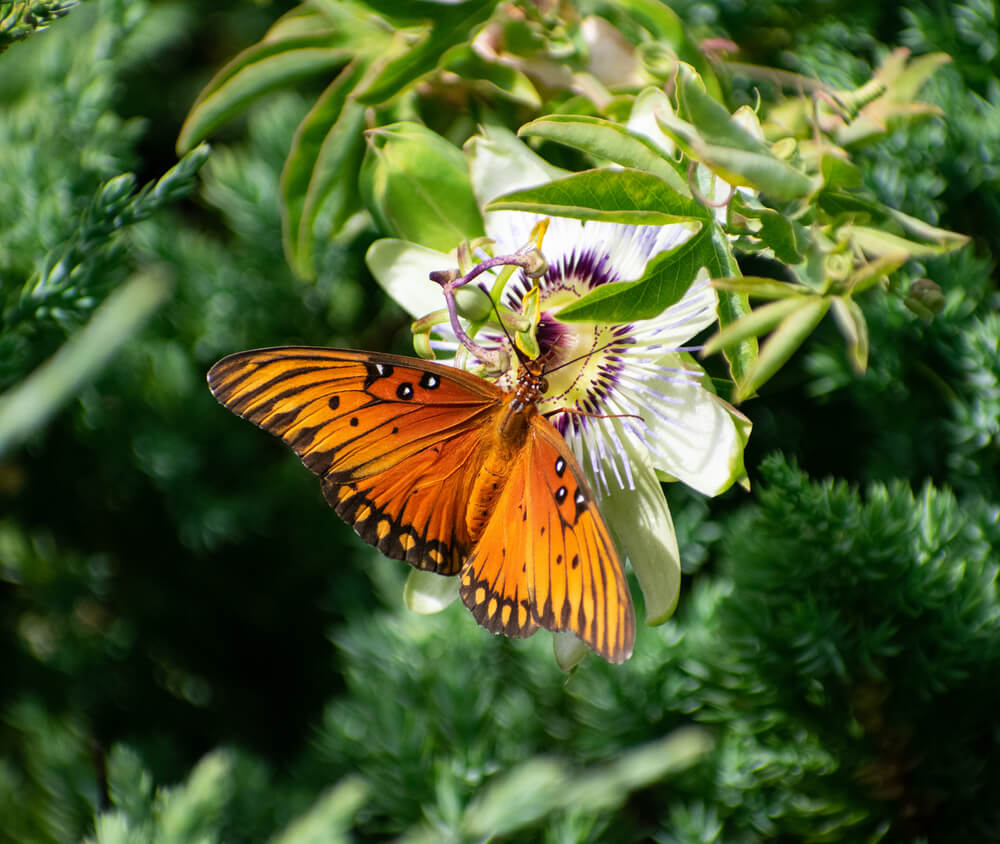
Don’t let the name fool you. This stunning orange beauty with silver spots travels way beyond the Gulf! It’s a passionate vine lover, specifically passion vine, making it perfect for gardeners who want to add tropical flair. The caterpillars are spiky orange creatures that won’t harm your vegetables, focusing instead on their beloved passion fruit plants.
- Markings: Bright orange wings with black markings.
- Host Plants: Passionvine (Passiflora spp.).
- Nectar Plants: Lantana, verbena, zinnia.
- Range: Southern U.S., migrates north.
These striking butterflies are closely related to longwings and can fly year-round in warm climates.
3. Clouded Sulphur (Colias philodice)
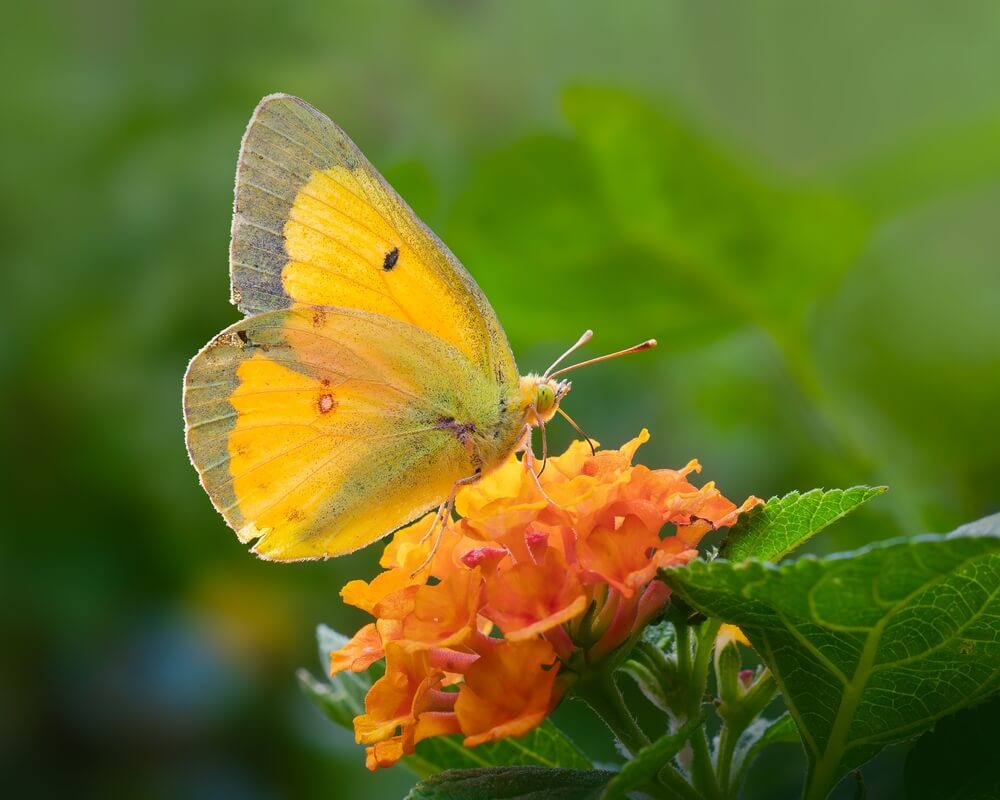
These cheerful yellow butterflies are like flying sunlight in your garden. They love legume plants like clover, alfalfa, and peas, which serve as food for their caterpillars. Adult butterflies sip nectar from various flowers and may even help with pollination as they feed. Their presence often points to open, sunny areas where legumes thrive. They’re also active from spring through fall and bring months of bright yellow motion to fields, roadsides, and gardens.
- Markings: Yellow wings with black borders.
- Host Plants: Clover, alfalfa.
- Nectar Plants: Aster, goldenrod, milkweed.
- Range: Nationwide.
Males have a distinctive dark border on their wings that females lack, making gender identification surprisingly easy as they flutter around your garden.
Read More – The 24 Best Shrubs And Flowers For Attracting Backyard Butterflies!
4. Viceroy (Limenitis archippus)
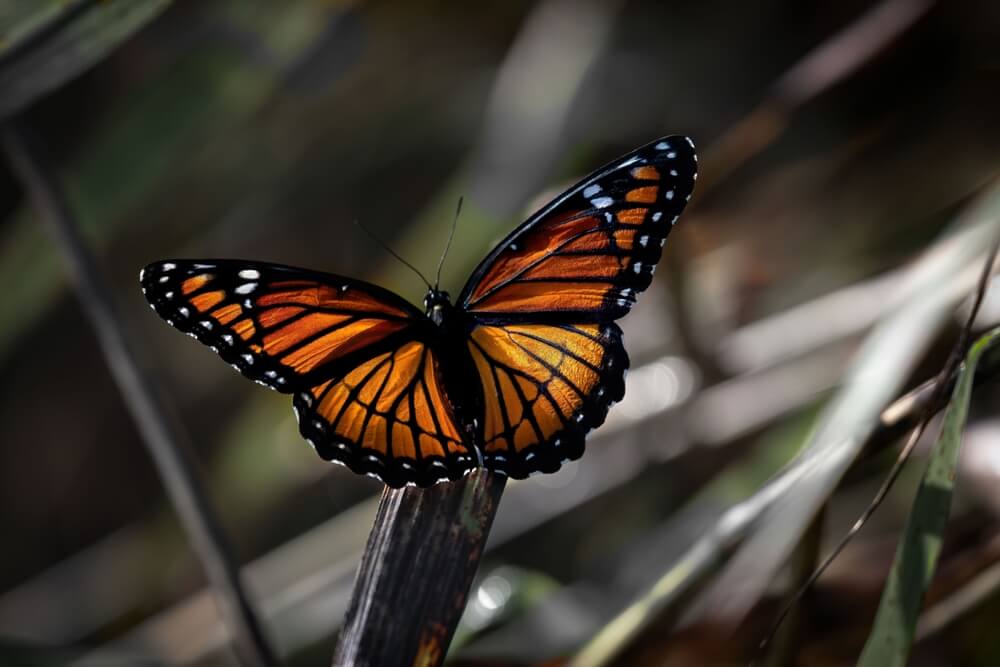
The Viceroy is one of nature’s most famous mimics! They resemble the iconic Monarch butterfly but are slightly smaller, with a key difference: a bold black line across its hindwings, like a ‘belt.’ This clever field mark makes it easy to tell them apart in flight. Viceroys lay their eggs on willow, poplar, and cottonwood trees, which prefer wet or riparian environments.
- Markings: Orange and black, mimics Monarch.
- Host Plants: Willow, poplar, cottonwood.
- Nectar Plants: Aster, goldenrod, milkweed.
- Range: Nationwide.
The black line across its hindwings is your foolproof field mark. Monarchs don’t have this distinctive “belt.”
5. Painted Lady (Vanessa cardui)
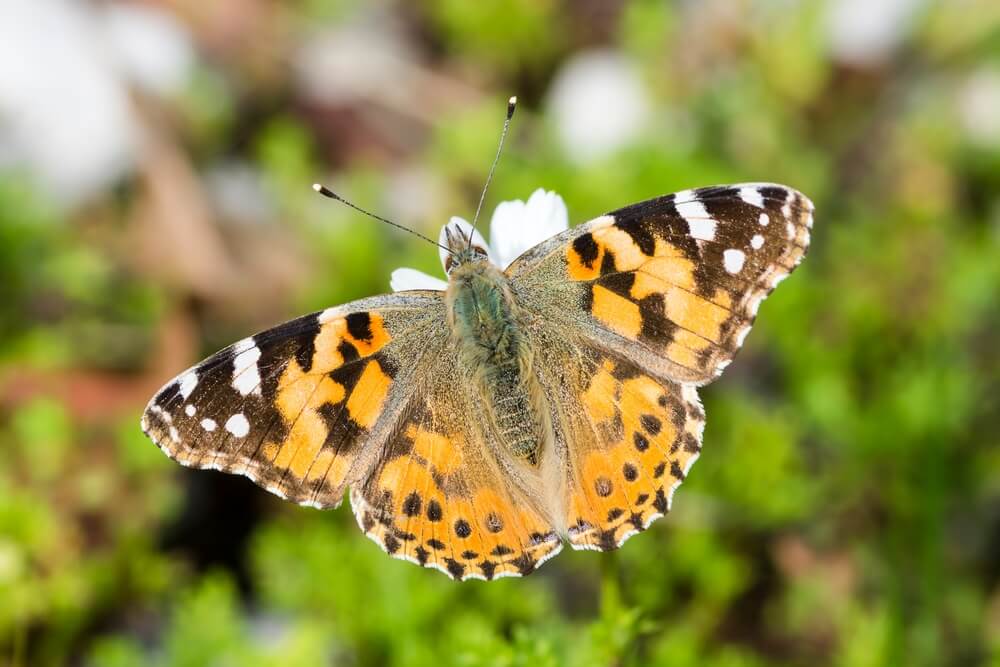
Perhaps the most well-traveled butterfly on Earth, the Painted Lady, is a gardener’s dream because it’s not picky. Its caterpillars feed on thistles, mallows, and dozens of other plants, many of them considered weeds. With salmon-pink wings decorated with black and white spots, it adds both beauty and movement to any garden. While not a primary pollinator, it visits many flowers and helps support garden biodiversity.
- Markings: Orange wings with black and white patterns.
- Host Plants: Thistle, hollyhock, mallow.
- Nectar Plants: Cosmos, zinnia, butterfly bush.
- Range: Nationwide, migratory.
This globe-trotter migrates across continents and can’t survive freezing temperatures, so northern populations are replaced by southern migrants each spring.
6. Black Swallowtail (Papilio polyxenes)
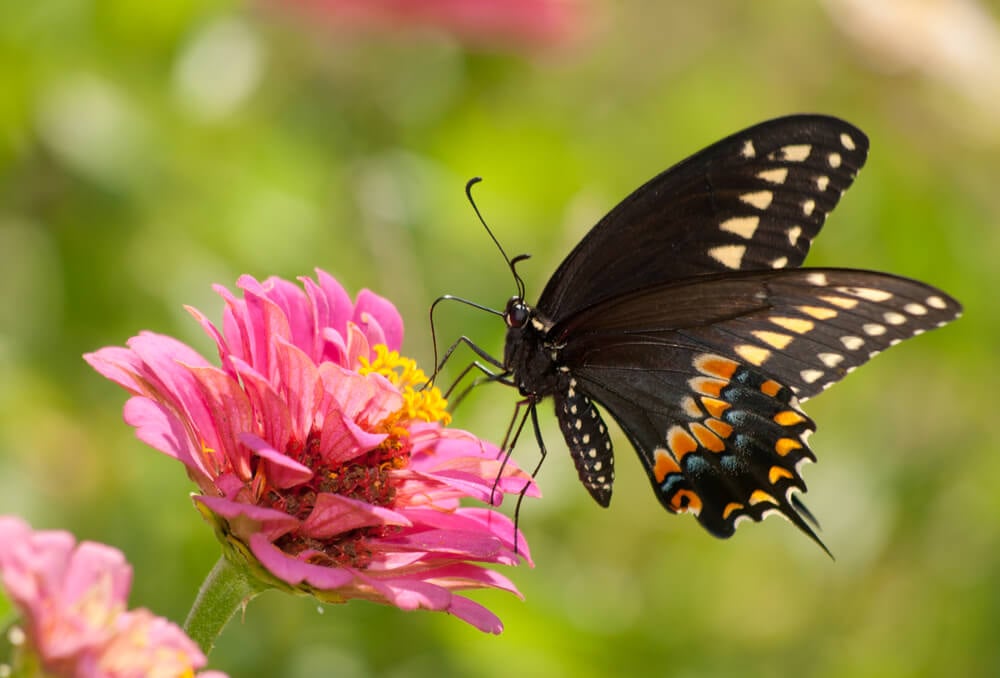
Here’s one you might recognize if you grow herbs. This elegant black butterfly with blue and yellow spots specifically seeks out parsley, dill, fennel, and carrot family plants. The caterpillars (adorable green, black, and yellow striped creatures) might munch on your herbs, but the trade-off is having these magnificent butterflies grace your garden with their presence.
- Markings: Black wings with yellow spots, blue and orange near the tail.
- Host Plants: Parsley, dill, fennel, carrot.
- Nectar Plants: Phlox, milkweed, thistle.
- Range: Eastern and Central US.
The caterpillars can extend bright orange “horns” (osmeterium) when threatened, releasing a foul-smelling substance to deter predators.
Read More – The 21 Best Flowers For Attracting Bumblebees, Native Bees, and Honeybees!
7. Common Buckeye (Junonia coenia)
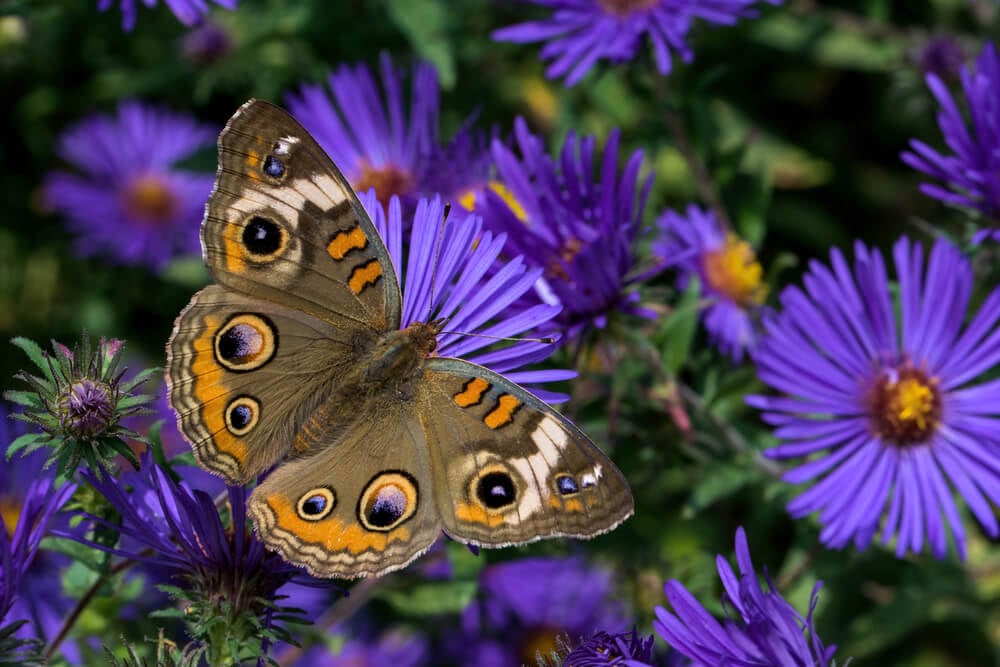
With prominent eyespots that look like they’re always watching, the Common Buckeye is a striking brown butterfly that loves plantain, snapdragons, and other common garden plants. It’s incredibly beneficial because it helps control plantain (a common lawn weed) while providing consistent pollination services throughout the growing season.
- Markings: Brown wings with colorful eye spots.
- Host Plants: Snapdragon, plantain, gerardia.
- Nectar Plants: Aster, chicory, coreopsis.
- Range: Nationwide, especially in Southern states.
Those prominent eyespots aren’t just for show. They’re strategically placed to startle predators and direct attacks away from vital body parts.
8. Pearl Crescent (Phyciodes tharos)
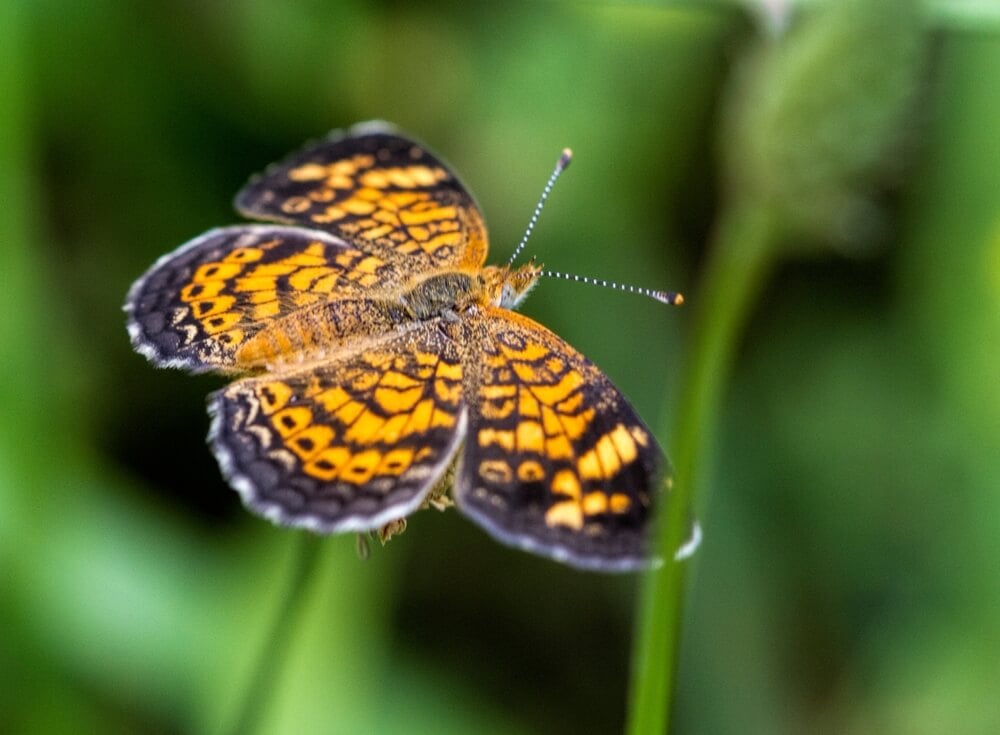
Small but mighty, this orange butterfly with intricate black markings is devoted to asters, making it perfect for wildflower gardens and native plant enthusiasts. They’re incredibly reliable, producing multiple generations per year, and their caterpillars feed exclusively on asters without typically causing significant damage to established plants.
- Markings: Small orange wings with black patterns.
- Host Plants: Aster.
- Nectar Plants: Clover, dandelion, fleabane.
- Range: Nationwide.
Males are territorial and will chase anything orange that flies through their patch, including much larger butterflies and even birds.
9. Western Tiger Swallowtail (Papilio rutulus)
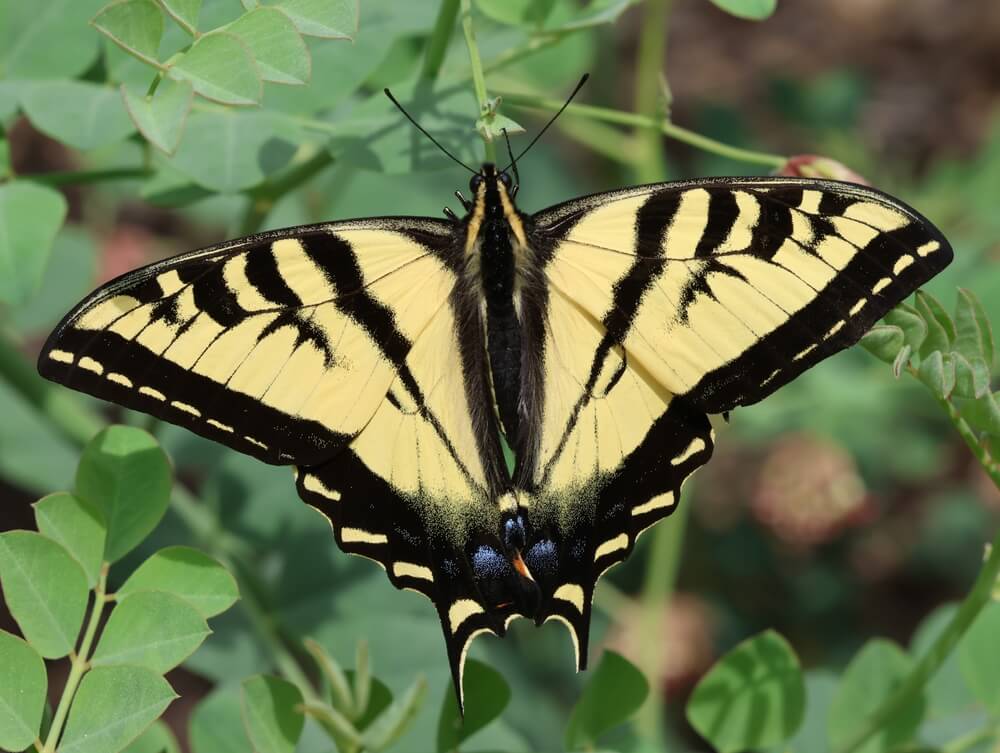
This massive yellow butterfly with black tiger stripes is a showstopper that loves cherry, willow, and cottonwood trees. Western gardeners treasure them because they’re regular pollinators of fruit trees and ornamental plants. The males are particularly social, often gathering at mud puddles to create spectacular “puddle parties.”
- Markings: Yellow wings with black tiger stripes, similar to Eastern Tiger.
- Host Plants: Willow, cottonwood, sycamore.
- Nectar Plants: Butterfly bush, thistle, zinnia.
- Range: Western US.
Western Tiger Swallowtail butterflies almost always have bright yellow wings with black stripes, whether they are male or female.
Read More – The 8 Best Ways To Support Local Pollinators And Native Bees In Your Backyard!
10. Cabbage White (Pieris rapae)
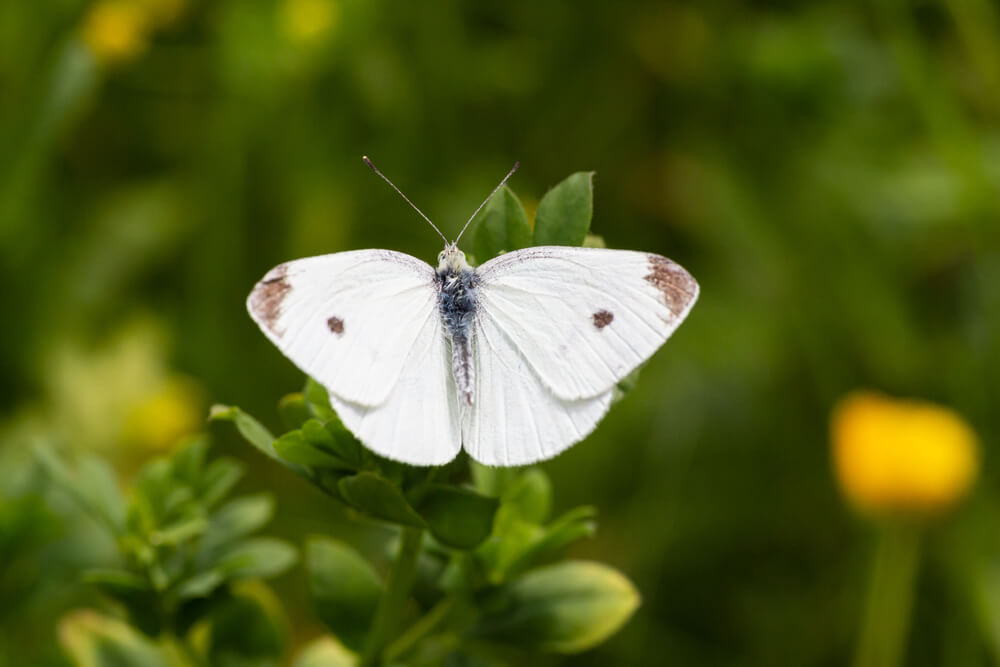
Before you groan about this common white butterfly, consider this: while their caterpillars do nibble brassicas, they’re excellent indicators of garden health and serve as important pollinators. Plus, they’re so abundant that they provide food for birds and spiders, creating a balanced ecosystem in your garden.
- Markings: Small white wings with black spots.
- Host Plants: Cabbage, broccoli, mustard greens.
- Nectar Plants: Alyssum, aster, clover.
- Range: Nationwide.
Originally from Europe, this successful immigrant has become one of the most widespread butterflies in North America. Some gardeners hate them. Others tolerate their beauty.
11. Red Admiral (Vanessa atalanta)
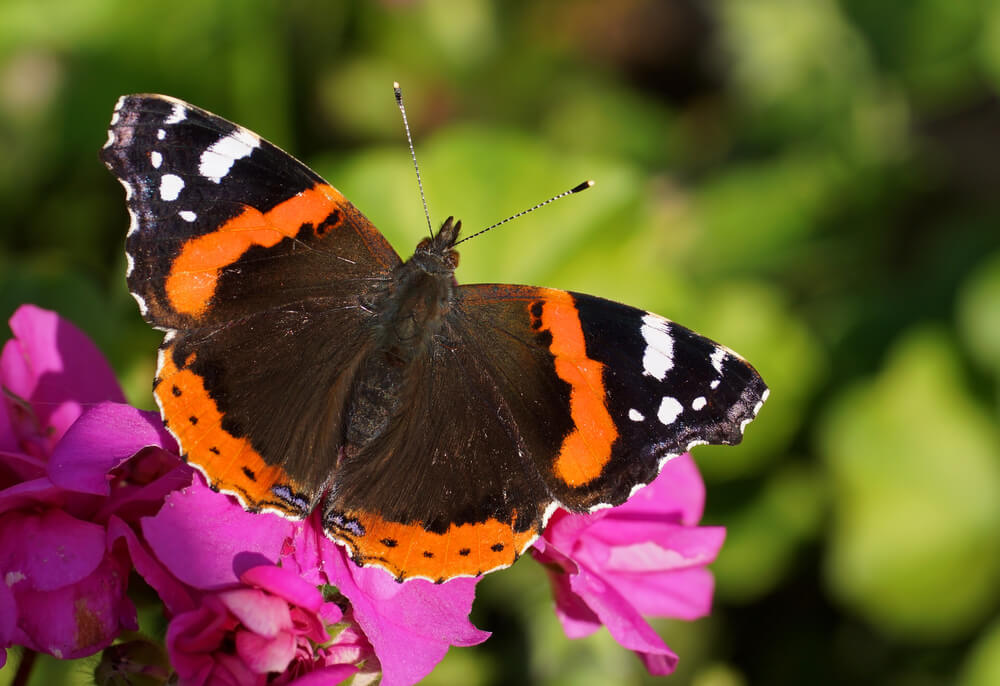
This sophisticated black butterfly, adorned with red bands and white spots, is particularly fond of nettle plants. They’re a frequent sight for gardeners who maintain wild, chaotic gardens. Red Admirals are also known for their bold, almost fearless personality around humans.
- Markings: Black wings with red-orange bands.
- Host Plants: Nettle, false nettle.
- Nectar Plants: Milkweed, stonecrop, clover.
- Range: Nationwide.
They’re known for their bold behavior, often landing on people and having “conversations” by opening and closing their wings.
12. Monarch (Danaus plexippus)
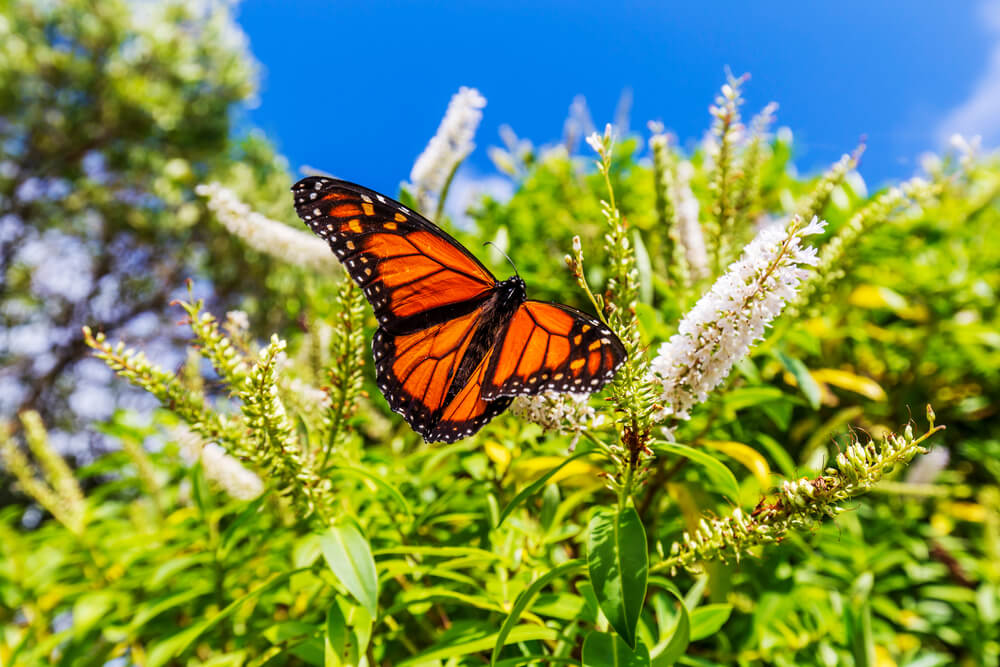
The superstar of the butterfly world, Monarchs are essential for any pollinator garden and exclusively depend on milkweed plants for their young. Their incredible migration story makes them garden celebrities, and they’re surprisingly easy to support. Just plant native milkweed and watch the magic happen. Every Monarch in your organic garden is part of a multi-generational journey spanning thousands of miles.
- Description: Iconic orange and black wings. It migrates long distances.
- Host Plants: Milkweed (Asclepias spp.).
- Nectar Plants: Butterfly bush, coneflower, zinnia.
- Range: Nationwide, especially during migration.
Their bright orange color warns predators that they’re toxic. It’s a chemical defense inherited from the milkweed they ate as caterpillars.
Read More – 21 Gorgeous Flowers For Attracting Hummingbirds Into Your Backyard!
13. Pipevine Swallowtail (Battus philenor)
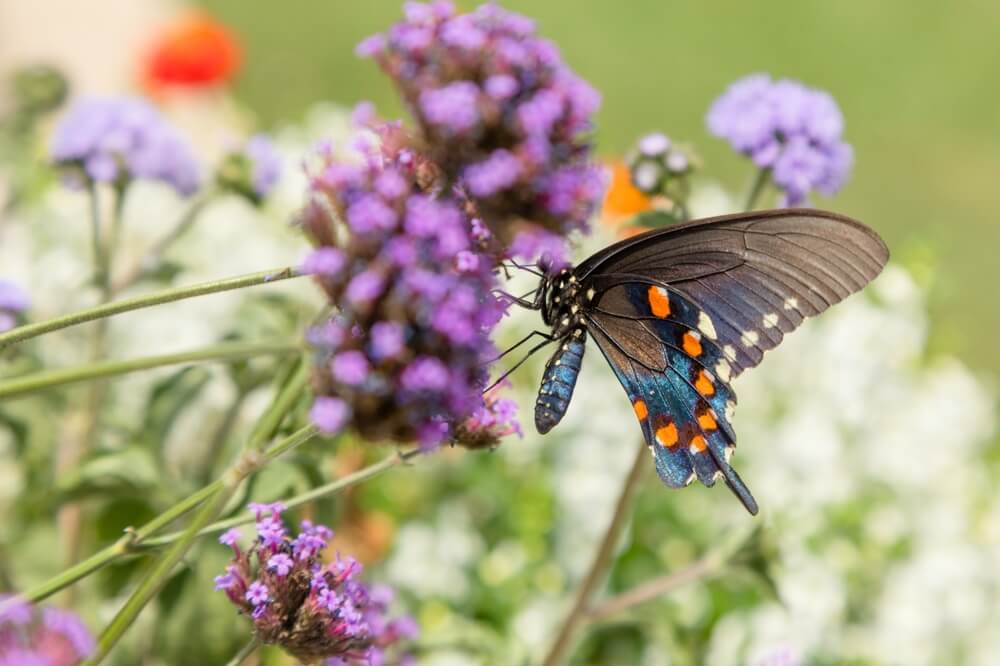
This iridescent blue-black beauty is a garden specialist that requires pipevine plants, making it perfect for gardeners who love unique, native climbing vines. The males shimmer with blue and green highlights that change in the light.
- Markings: Black wings with iridescent blue hindwings.
- Host Plants: Pipevine (Aristolochia spp.).
- Nectar Plants: Thistle, butterfly bush, azalea.
- Range: Throughout much of the southern US, from the Gulf Coast northward to near Chicago and southern New England, and westward from the Atlantic coast to Arizona and California, with some isolated populations farther north.
The Pipevine Swallowtail is also toxic for predators to eat! Other butterflies mimic this toxic species for protection, making it the “model” in several mimicry complexes.
14. Eastern Tiger Swallowtail (Papilio glaucus)
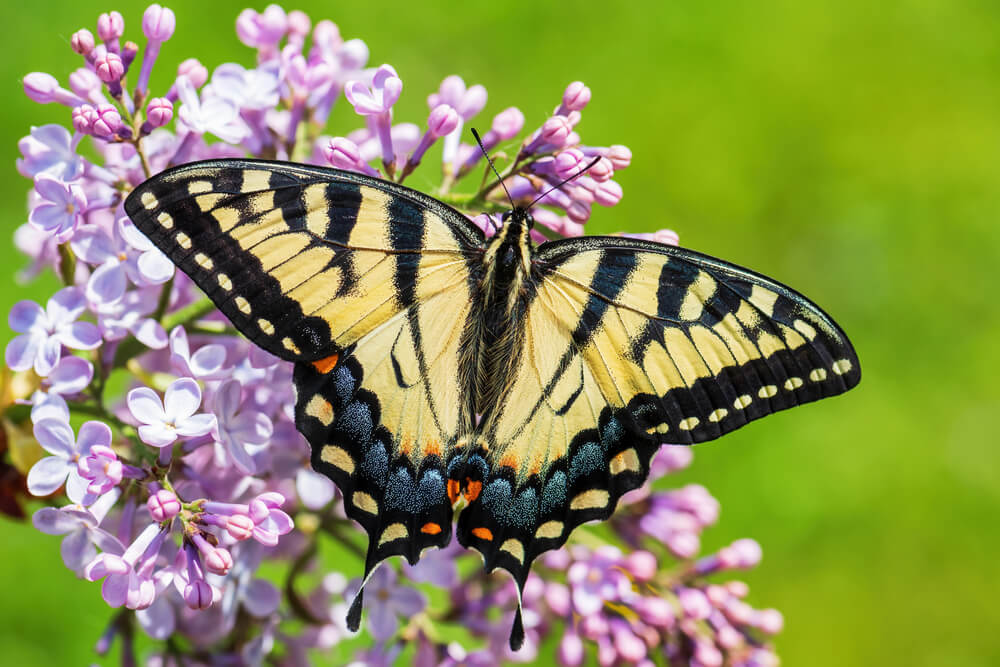
One of the most recognizable butterflies in North America, this immense yellow beauty with black stripes is fond of cherry, tulip, and lilac trees. Eastern gardeners prize them because they’re gorgeous pollinators for both ornamental and fruit trees, and their caterpillars develop on trees rather than competing with tender garden plants.
- Markings: Large yellow wings with black tiger stripes. Females may be black.
- Host Plants: Tulip tree, wild cherry, ash.
- Nectar Plants: Joe-Pye weed, lilac, honeysuckle.
- Range: Eastern and Central US.
Large females sometimes come in a dark form that mimics the toxic Pipevine Swallowtail. It’s nature’s version of borrowed protection.
15. American Lady (Vanessa virginiensis)
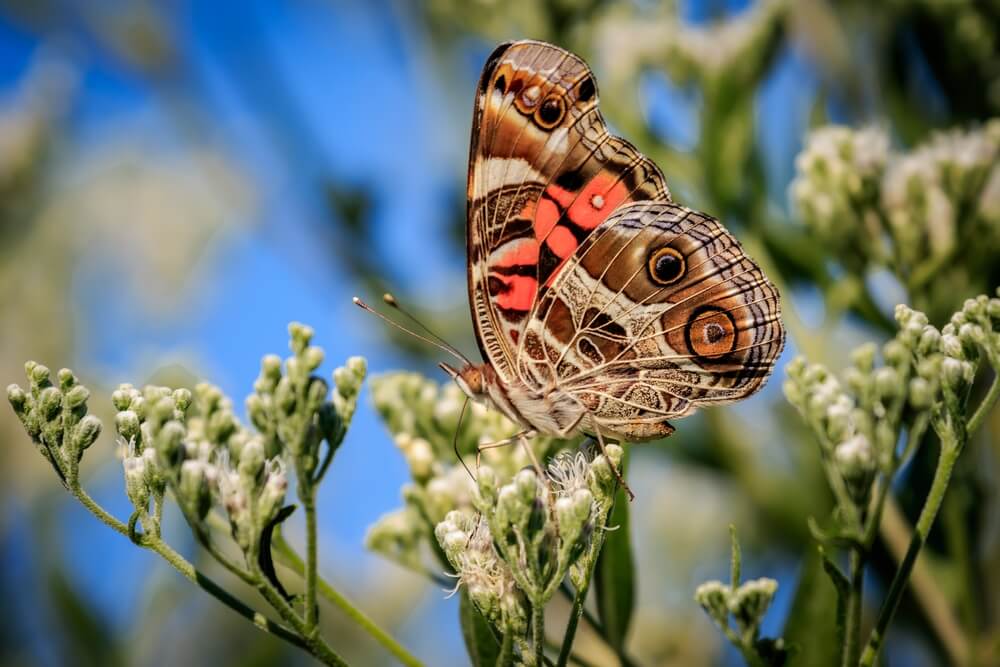
Distinguished from the Painted Lady by its larger eyespots, the American Lady is a cudweed and everlasting specialist who loves xeriscaping and low-maintenance gardens. They’re incredibly drought-tolerant and help gardeners manage weedy areas while providing some pollination services.
- Markings: Similar to Painted Lady but with distinct eye spots.
- Host Plants: Pussytoes, everlasting, cudweed.
- Nectar Plants: Aster, goldenrod, marigold.
- Range: Nationwide.
You can distinguish it from the Painted Lady by counting eyespots. American Ladies have two large ones on the hindwing underwing.
Read More – How To Keep Bumblebees, Hornets, And Wasps Away From Hummingbird Feeders!
16. Giant Swallowtail (Papilio cresphontes)
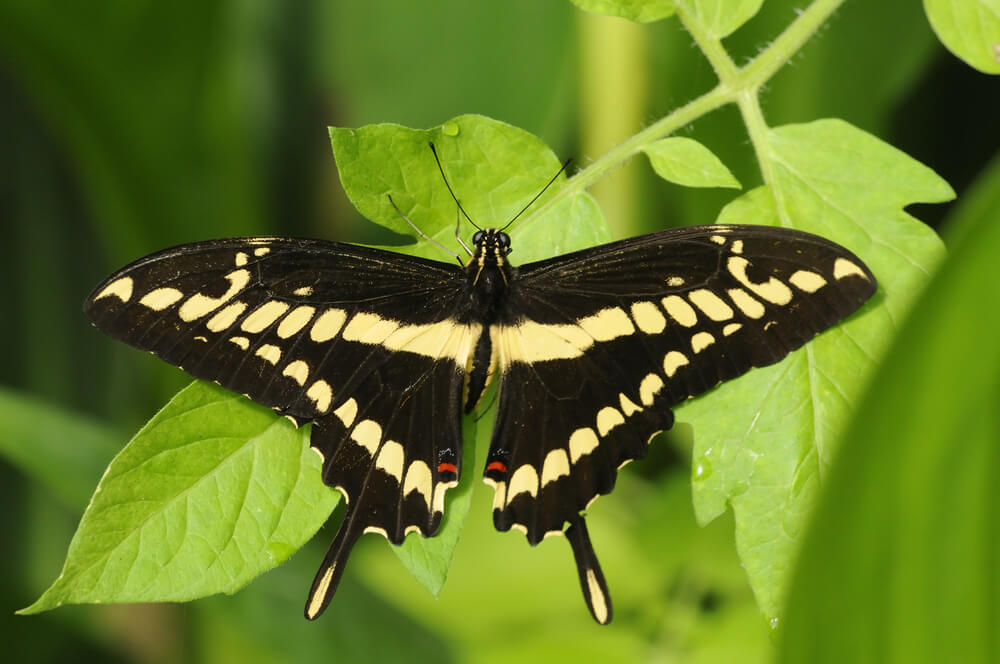
True to its name, this is the largest butterfly in North America, with striking yellow and black patterns that make it look almost tropical. Citrus growers know them well since the caterpillars (called “orange dogs”) feed on citrus trees, but the spectacular adults are worth the occasional leaf damage for their incredible pollination services.
- Markings: Large, dark wings with yellow bands.
- Host Plants: Citrus, prickly ash, rue.
- Nectar Plants: Lantana, azalea, milkweed.
- Range: North America and extending to Venezuela, Colombia, and parts of the Caribbean.
The caterpillars look exactly like bird droppings, complete with a shiny, wet appearance that’s remarkably convincing.
17. Cloudless Sulphur (Phoebis sennae)
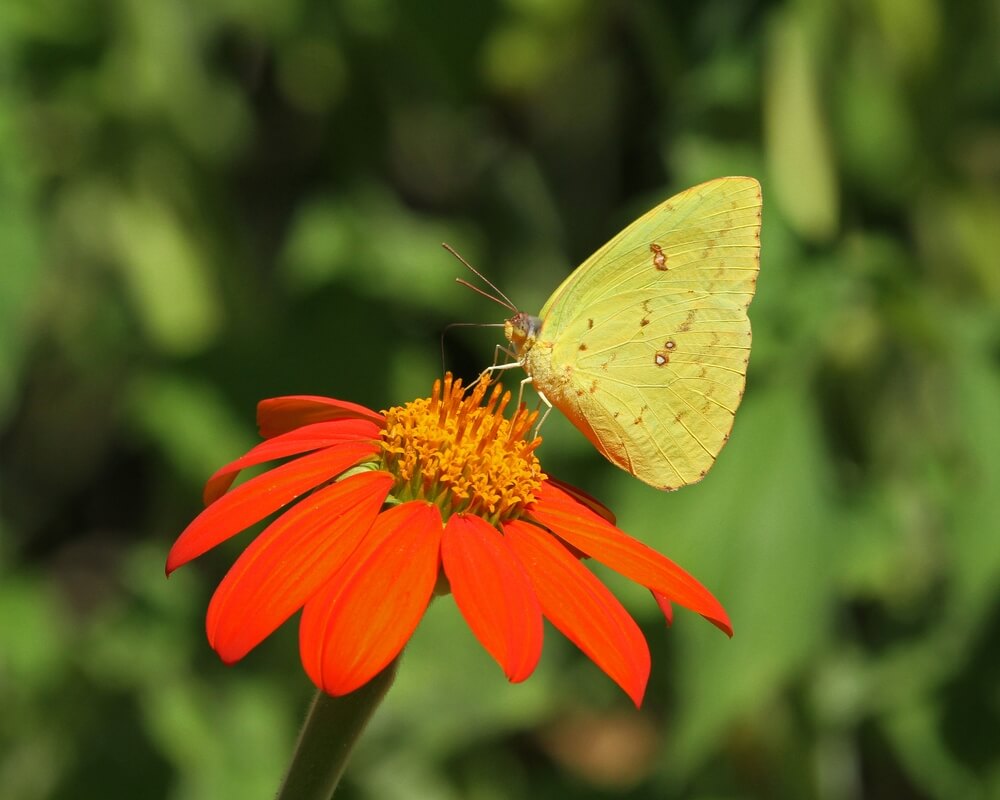
This bright yellow powerhouse (males) or pale yellow beauty (females) is a strong migrant that loves senna plants and other legumes. They’re fantastic for southern gardeners because they’re active year-round in warm climates and provide helpful pollination for a wide variety of shrubs and plants, not just their host species.
- Markings: Large, bright yellow wings.
- Host Plants: Senna, cassia.
- Nectar Plants: Lantana, cardinal flower, salvia, and many more.
- Range: Southern U.S., migrates north.
These powerful fliers can cover hundreds of miles during migration, often seen streaming southward in impressive numbers during fall.
18. Zebra Swallowtail (Eurytides marcellus)
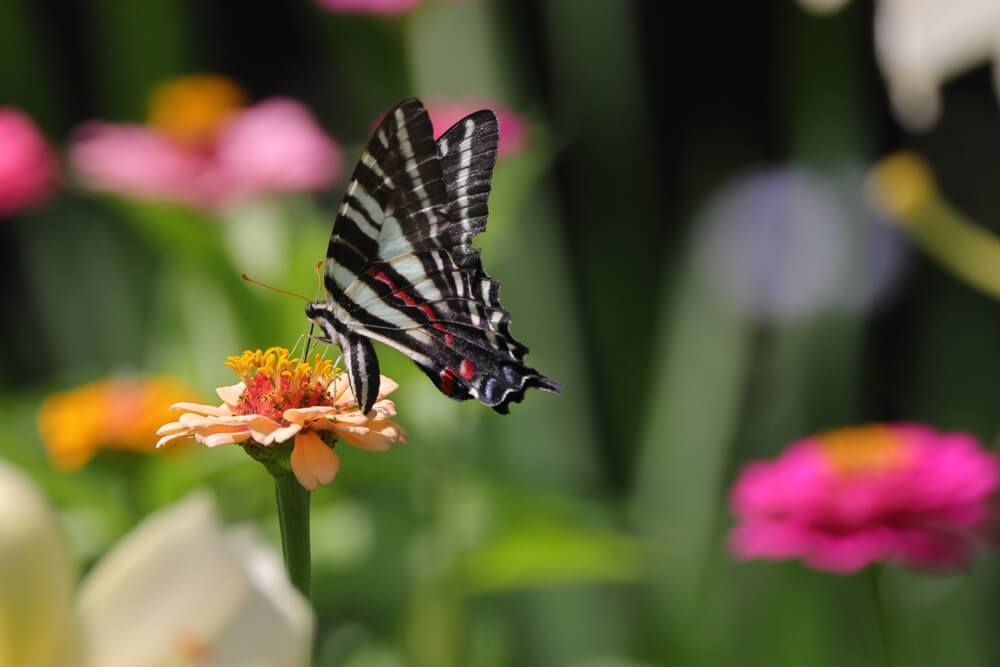
With its distinctive black and white stripes and red spots, this butterfly is unmistakable and utterly dependent on pawpaw trees. It’s a specialist that rewards gardeners who plant native pawpaws with its elegant presence, and it can serve as an excellent indicator of healthy riparian ecosystems.
- Markings: White wings with black zebra-like stripes.
- Host Plants: Pawpaw (Asimina triloba).
- Nectar Plants: Milkweed, dogbane, verbena.
- Range: Eastern US, less common.
Its unusually long tails and triangular wing shape make it one of the most distinctive swallowtails in flight.
Read More – 23 Best Companion Flowers For Veggie Gardens – From Bee Balm And Butterfly Bush To Sunflowers!
19. Mourning Cloak (Nymphalis antiopa)
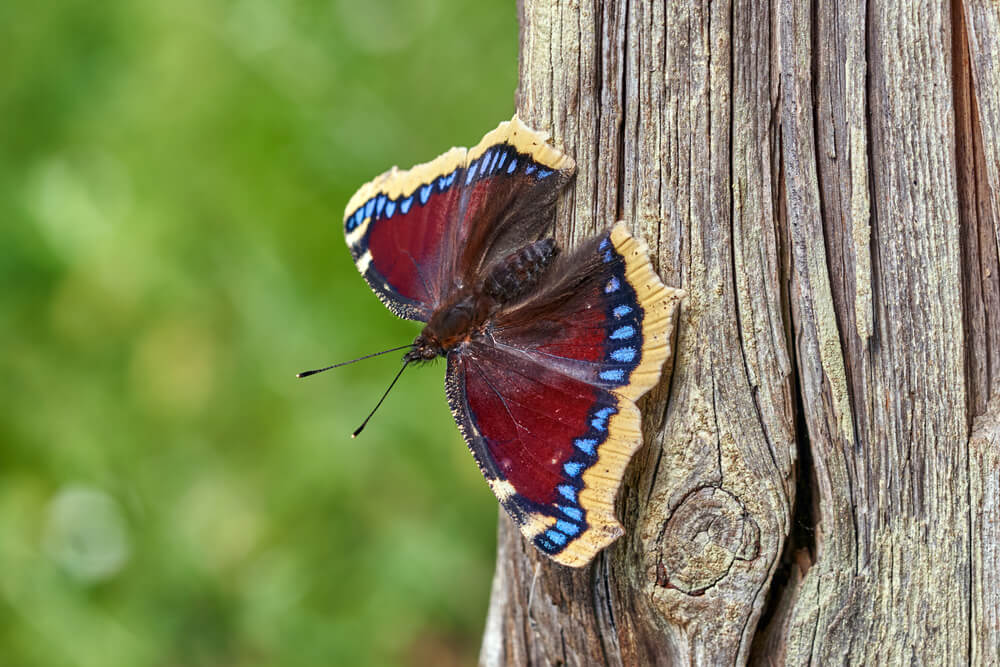
This large, dark butterfly with yellow borders is one of the longest-lived butterflies, overwintering as adults and emerging early in spring. They prefer willow, elm, and birch trees, making them perfect for gardeners with naturalized areas. Their early emergence makes them crucial pollinators for plants that bloom early.
- Markings: Dark brown wings with yellow borders and blue spots.
- Host Plants: Willow, elm, hackberry.
- Nectar Plants: Tree sap, overripe fruit, milkweed.
- Range: Nationwide, early spring.
These butterflies can live up to 10 months, making them some of the longest-lived butterflies in North America.
20. Orange Sulphur (Colias eurytheme)
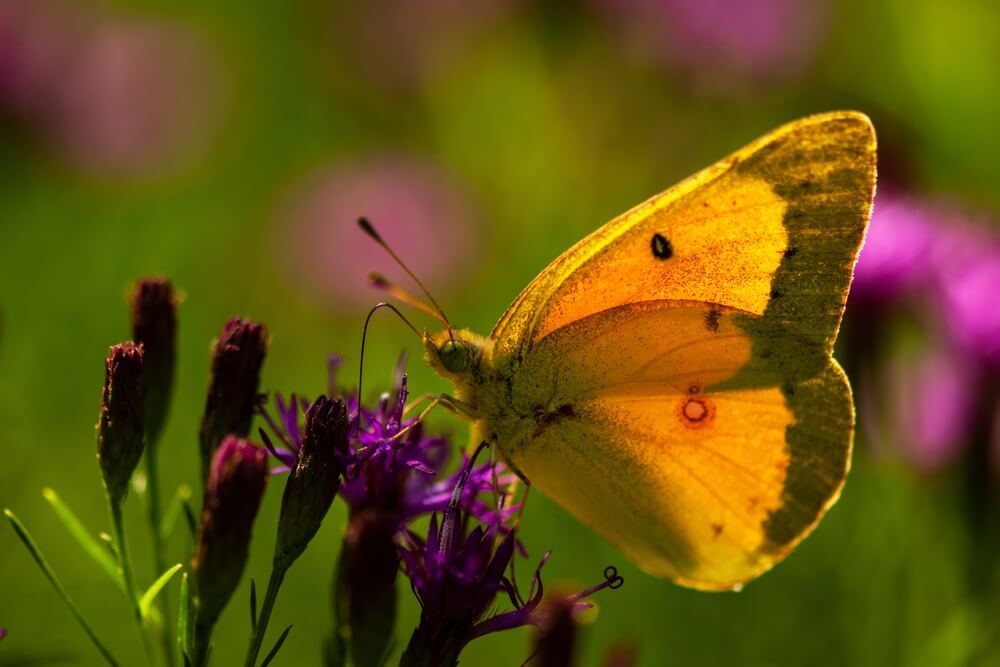
Often called the “Alfalfa Butterfly,” this orange beauty is a specialist in legumes that can be both fascinating and challenging for gardeners. The adults are attractive nectar-feeders who visit flowers like zinnias and asters. But, their caterpillars feed on alfalfa, clover, vetch, and other legumes. In agricultural settings, they’re sometimes considered pests when populations boom, but in home gardens, they’re generally manageable and add vibrant color to the landscape.
- Markings: Bright orange-yellow wings with black edges.
- Host Plants: Alfalfa, vetch, clover.
- Nectar Plants: Zinnia, aster, dandelion.
- Range: Nationwide.
The white-form females are so different they were once thought to be a separate species entirely.
21. Great Spangled Fritillary (Speyeria cybele)
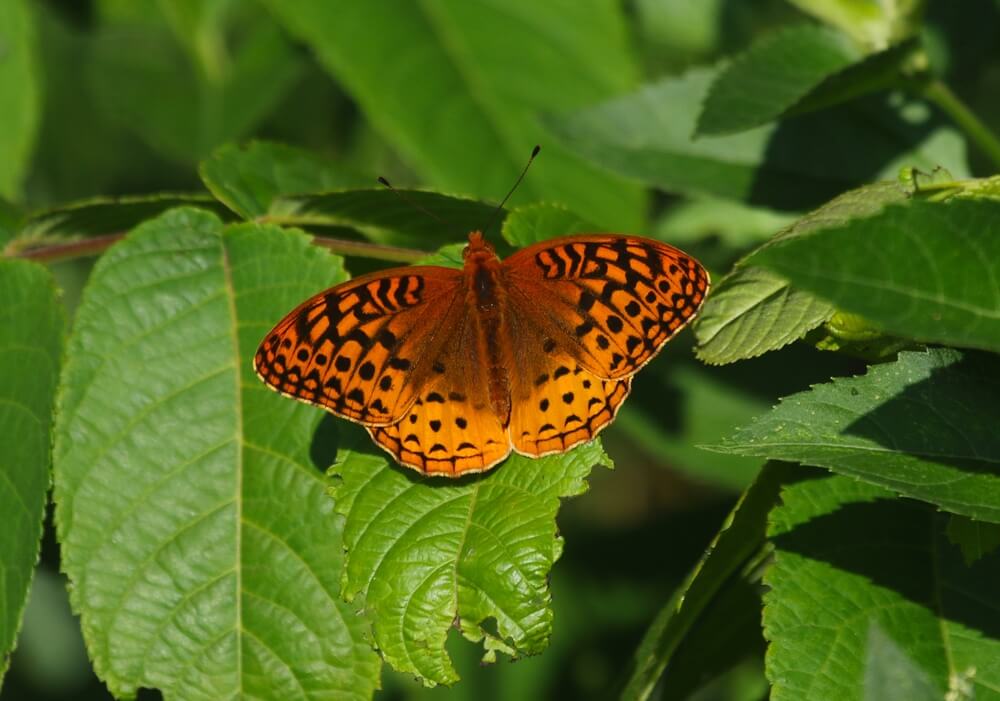
This large, orange butterfly with silver spots underneath is a violet specialist who often dwells in woodland gardens and shaded areas. They have a fascinating life cycle where caterpillars overwinter and emerge in spring to feed on violets, making them excellent partners for gardeners who maintain diverse, naturalized spaces.
- Markings: Large, vibrant orange butterfly with black markings and checker-like patterns. Prominent silvery spots (“spangles”) on the underside of the hindwings. Females are slightly darker than males.
- Host Plants: Violets (Viola species). These are the only plants the caterpillars eat.
- Nectar Plants: Common milkweed, Joe Pye weed, purple coneflower, butterfly weed, asters, black-eyed Susan, blazing star, goldenrods, wild bergamot, thistles, mountain mint, and swamp milkweed.
- Range: From southern Canada down through the northeastern and central United States.
Only the males have distinctive scent patches (androconia scales) on their forewings that release pheromones during courtship.
Read More – 21 Yummy And Edible Flowers For Growing In Your Garden!
Conclusion
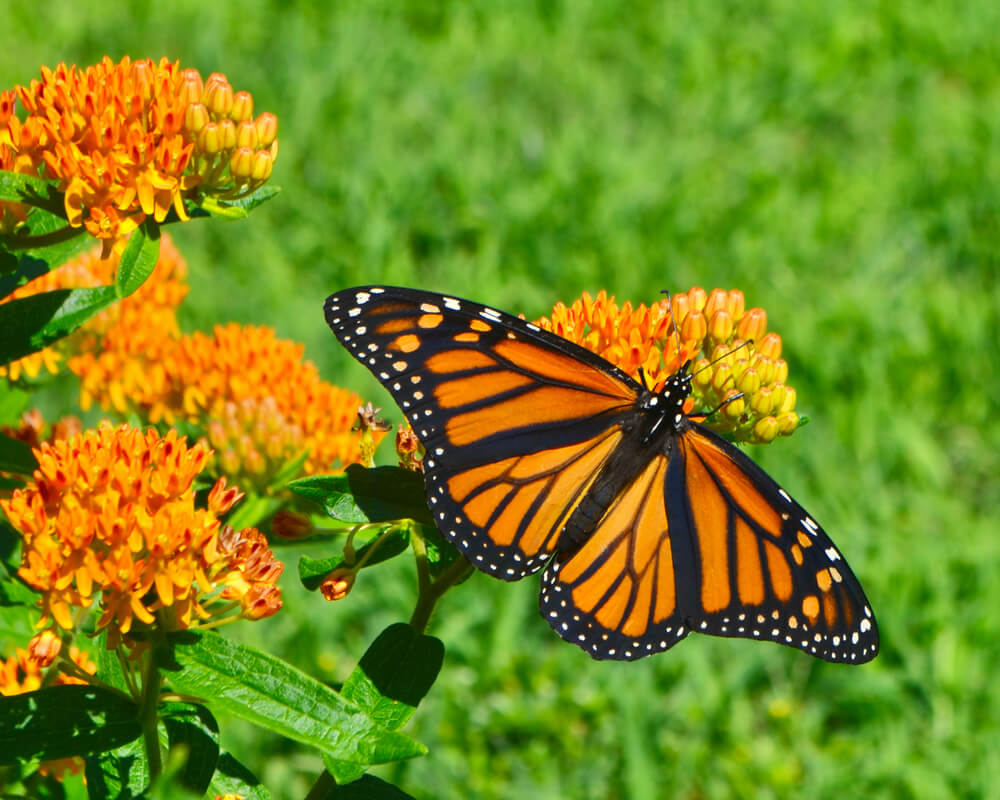
These majestic butterfly species represent just a fraction of the incredible diversity waiting to grace your garden. Remember, every butterfly in your garden is both a reward for good gardening practices and a promise of the beauty that comes when we work with nature rather than against it. Plant native species, avoid pesticides, and watch as your garden becomes a living canvas painted with wings.
What about you?
- Have you seen any of these beautiful butterfly varieties in your yard?
- Have you seen any butterflies not listed here?
- Are you going to grow some lovely native crops to help attract butterflies?
Thanks for reading.
Have a great day!






